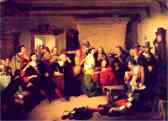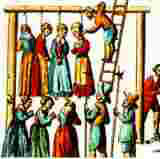
They Live Again
Lydia
Gilbert
A Victim of the Witchcraft Madness

"Believing
in witchcraft was not perceived as unusual. The smartest people in the colonies
would blame events on witchcraft. It was connected to the culture they brought
with them from Europe," says Premo. Even children were jailed for
witchcraft and in 1692, Massachusetts governor William Phips ordered a halt to
the trials when his own wife, Lady Mary Phips, was suspected of witchcraft.
Who
Lydia Gilbert's accusers were is unknown. Whether
ignorant gossip or private enmities brought this ghastly charge upon her, it is
impossible to say. That the charge
of procuring the death of Henry Stiles could be brought her seems incredible,
when everyone of mature ages in
Windsor must have known that Henry Stiles met his death by the
carelessness of Thomas Allyn, three years before (as a result of a firearms
accident which Allyn had been tried upon).
But this charge was brought against her.
She was charged with other witchcraft besides this, and it may be that
she was one of those unfortunate women to whom suspicion of witchcraft clung,
for reasons which cannot now be stated. The evidence upon which Lydia was
convicted, and the names of the witnesses against her, are unknown.
The jury brought in the indictment and the records seem to show that they brought in the verdict as well. These two functions of a jury are separate in our time, but in 1654 it was not so. This seems repugnant to our ideas of justice. We should like to hope that the Court proceeded after the ancient English manner, receiving the indictment from the jury, hearing the evidence and deciding in accord therewith.
The Juror's Oath
You
do sware by the Ever living god that you will diligently enquire and faithfully
present to this Court what soe Ever you know to bee a Breach of any Established
Law of this Jurisdictyon so far as may conuce to the glory of god and the good
of the commonwealth as also what Oreginall offences you shall Judge meete to be
presented, as you expect helpe from god in Jesus Christ.
The
Indictment
Lydea GiIburt thou art heere indited by that name of Lydea Gilburt that not hauing the feare of god before thy Eyes thou hast of late years or still dust giue Entertainement to Bather [sic] the greate Enemy of god and mankinde and by his helpe hast killed the Body of Henry Styles besides other witchcrafts for which according to the law of god and the Estableshed law of this Comon wealth thou deservest to Dye.
Ye Party aboue mentioned is found guilty of witchcraft by the Jury.
Sources:
THE ENGLISH ORIGIN OF THOMAS GILBERT OF BRAINTREE, MASS., AND WETHERSFIELD, CONN. By Douglas Richardson, M.A.. The American Genealogist, July 1992
Drake,
Frederick C. "Witchcraft in the American Colonies, 1647-62" American
Quarterly 20 (1968):694-725)
The
Hanging of a Witch Dog
John
Bradstreet of Rowley was arrested and tried at Salem in 1652, "for having
familiarity with the devil." In court he admitted that he "read a book
of magic and heard a voice asking what work I had for him," meaning that he
had used magic to get the devil to talk to him. Bradstreet testified under oath,
"I asked the devil to make a bridge of sand over the sea, and make a ladder
of sand to heaven, then go to God and come to me no more." The Magistrates
found John only guilty of lying and ordered him to be fined and whipped. He
found himself in another dilemma in 1692, however, when he was accused of
witchcraft. He was indicted for "inciting a dog to afflict others,"
which could mean a death sentence during Witch Times. John ran away and hid in
the woods, thus avoiding the hangman, but the dog he incited to give two teenage
girls "the evil eye," was hanged.
Never
Walk Under a Ladder

One superstition from witch-hanging days that persists to this day is never to walk under a ladder. The reason is that when a witch was pushed from the ladder at the gallows, she usually dropped under the ladder, and if you were standing there, this "fire-brand of hell" might touch you. It was thought that if a witch touched anything, especially during her last gasp on earth, it would soon die. Therefore, it was believed that if you walked under a ladder leaning on the gallows tree even after the witch had been cut down and disposed of, her curse might still be lingering there, and you would die within a year.
|
Compiled by
Richard N. Fox |
|
|
Web design by Richard Fox |
|